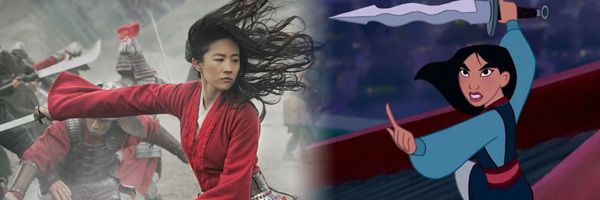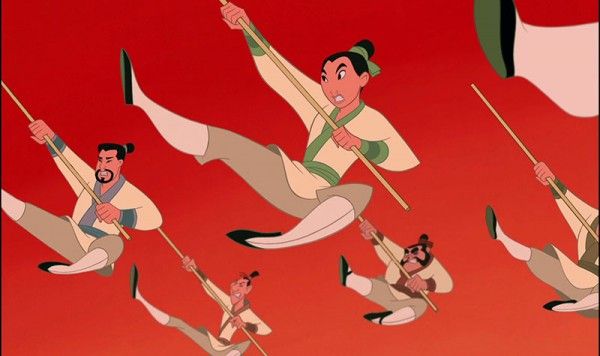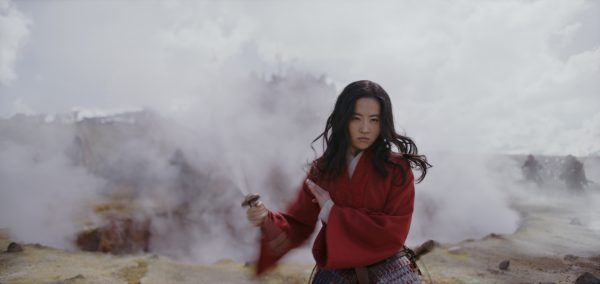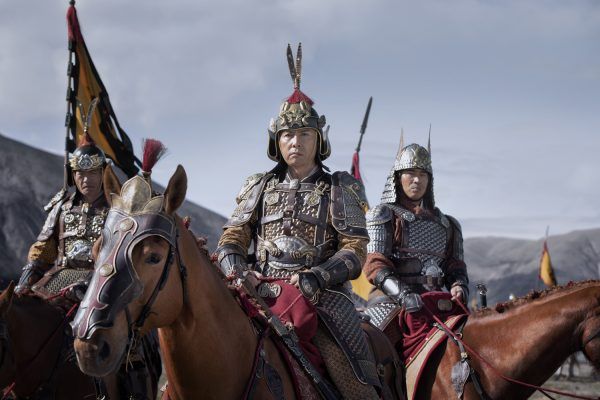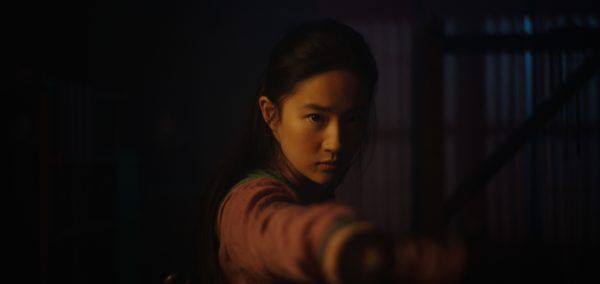Disney’s new Mulan, which just debuted (for a premium!) on Disney+, is easily one of the very best live-action adaptations of one of their beloved animated classics. It’s a muscular historical action movie, full of gorgeous cinematography (actually shot on location!) and great performances (anchored by an amazing Liu Yifei in the title role). And unlike some other live-action remakes (we’re looking at you, Beauty and the Beast), it isn’t a shot-for-shot recreation and instead strays far from the source material in several key areas. These aren’t necessarily bad changes, after all, just changes.
Below are some of the most striking differences from the 1998 animated Mulan to this new Mulan. And these are the just biggest changes. For example, while almost every character has a different, more authentically Chinese name, the characters are essentially the same (Shan Yu for example becomes Bori Khan but other than that they’re pretty much identical). We’re sticking with the bigger changes, to both the story and characters. So grab your lucky cricket and hold on tight.
The Castle
When the movie opens, we’re greeted with the familiar, glittery Disney logo (the original Mulan had the more traditional, 2D “Walt Disney Pictures” logo from that period). But this time the castle is different. A movie-specific castle isn’t all that rare but it is always super exciting (our favorites include the Tron Legacy castle that placed it on the grid or the retro-futuristic Tomorrowland castle, Space Mountain beaming in the background, a jet age rocket pack replacing the magical twinkle). And international Disney fanatics will undoubtedly instantly recognize the castle that appears before Mulan – it’s Enchanted Storybook Castle, the mammoth visual centerpiece of Shanghai Disneyland. Of course, this is hugely symbolic and synergistic – the Shanghai Disneyland park is the first Disney park in mainland China and cemented the company’s foothold in the Middle Kingdom (with its restrictions on Western popular culture and state-run television, Disney had been blocked from the country for decades). Former Disney CEO and current chairman Bob Iger had made the Shanghai Disneyland project a cornerstone of his tenure; it was a lengthy and painful process that took an insane amount of time to get approved and built (he details it thoughtfully in his memoir). Mulan is another expression of Disney’s courtship of China. When the original Mulan was released in 1998 it was dismissed as being “too western” and notoriously bombed at the box office. This new Mulan was explicitly created to woo jaded Chinese audiences. And a great way to do that is to begin the movie with a symbol they all now know (and hopefully love) – the miraculous castle from Shanghai Disneyland.
There Aren’t Any Songs
Back in 2017, it was revealed that this new Mulan wasn’t going to have any of the great (and honestly sort of underrated) songs by Matthew Wilder and David Zippel, including “Reflection,” “Honor to Us All,” and “I’ll Make a Man Out of You.” And that has turned out to be true – there aren’t any songs in the live-action Mulan. But that doesn’t mean there aren’t references to the songs, both in the admittedly so-so score by Harry Gregson-Williams (you’ll miss Jerry Goldsmith’s recognizable themes and unique instrumentation – those synths!) and in dialogue recited by Mulan and other characters. Also Christina Aguilera, who memorably sang the pop music version of “Reflection,” has an updated version in the credits overseen by Wilder along with a new, fairly catchy tune called “Loyal Brave True,” which contains instrumentation from Gregson-Williams’ score. (Sadly 98 Degrees and Stevie Wonder didn’t return for a new rendition of “True to Your Heart.”) So while the songs might be gone from the body of the movie, they’re far from forgotten.
Goodbye Mushu, Hello Nameless Phoenix
Upon, er, reflection, Mushu, the wise-talking dragon voiced by Eddie Murphy (years before he would serve as a similarly smart-ass sidekick in Shrek) maybe wasn’t the greatest idea. While the character is hilarious and offers some unexpected emotion, him being voiced by a non-Asian character is clearly problematic (more on that in a minute) and while its design is striking and evocative of the calligraphic aesthetic the entire movie employs (done by the wizards at the Walt Disney Feature Animation outpost at what was then Disney-MGM Studios in Orlando, Florida), he could just as easily be the mascot for a culturally insensitive Chinese fast food restaurant chain. While Mushu (and the coterie of familiar ancestor ghosts, since the Chinese exhibition has a big problem with the supernatural) deep-sixed, the creators of the new Mulan gave him an elegant, more abstract replacement – a phoenix. The phoenix (which was weirdly also a plot point in last year’s underseen Maleficent: Mistress of Evil) is the family symbol and follows Mulan. It doesn’t interact as overtly as Mushu did (who regularly got characters into and out of trouble), but it does guide Mulan occasionally when she needs it and is a very striking image, its long tail fluttering in the wind. And no, the phoenix doesn’t talk either. Bummer.
Mulan Doesn’t Cut Her Hair
In the sequence where Mulan steals her father’s armor and sword and heads off into battle, there are some remarkable similarities between the animated film and the live-action remake including, notably, her leaving her jade hairpin behind to let her family know it was her. But there is one key, crucial difference: Mulan doesn’t slice off her hair. Instead, 2020 Mulan simply ties her flowing locks into a bun. Not only is this not as dramatically satisfying it’s also not as visually powerful (also the new sequence is in desperate need of the Goldsmith “Mulan’s Decision” soundtrack cut). It does lead to a cool moment later on when, in the heat of battle, Mulan makes the decision to discard her disguise (instead of like in the original film when she’s wounded and her identity is revealed); when she takes her knot out her hair flows brilliantly on the battlefield. So there’s that.
Cricket Is Now a Human Man
Mulan’s animated inhuman friends don’t really make the translation to the live-action feature, sadly but the strangest moment is when a character, who looks and sounds a lot like Chien-Po from the original film introduces himself as Cricket. He even mentions that it’s because he’s “lucky,” a character trait assigned to crickets in Eastern cultures and the thing that set Mulan’s cricket sidekick Cri-kee apart. (When he confesses to Mushu that he isn’t even lucky, it’s a big moment.) Why they couldn’t just give Mulan another cricket (the character doesn’t speak in the original) is pretty strange but turning the cricket character into a human man is even weirder. If you don’t hit pause and say, “Wait what?” you’ll have done better than me.
Every Cast Member Is Actually Asian
Consider this a major plus of the new movie. In 1998’s Mulan, the Asian characters were voiced by a mishmash of ethnicities including, unfortunately, the very white. Consider that Harvey Fierstein, gravelly-voiced Broadway veteran, plays one of Mulan’s fellow soldiers or that Miguel Ferrer, George Clooney’s cousin, played Shan Yu, invading Han villain. Less offensive but still pretty unthinkable in this day and age is the fact so many Japanese actors played Chinese characters, including the American-born, but Japanese-descended, Pat Morita (who played the Emperor of China) and George Takei as one of Mulan’s bitchier ghostly ancestors. This new Mulan is much more rigid when it comes to its Chinese casting (including legends like Gong Li, Jet Li, and Donnie Yen) and that authenticity goes a long way in adding to the movie’s realism and believability. Also, keep your eyes peeled for a cameo from the original Mulan herself, Ming-Na Wen!
Mulan Has a Sister (But No “Little Brother”)
This is relatively minor but a curious swap: in the original animated feature, Mulan had a rascally pet dog named Little Brother (voiced by Head of Story Chris Sanders, perhaps gearing up for his role as Stitch a few years later). In the new movie, Mulan actually has a little sister. Her name is Hua Xiu (played by Xana Tang) and she is afraid of spiders (which leads to a complete rejiggering of the matchmaker sequence). Giving Mulan a sister doesn’t add a whole lot to the story but it does reinforce the movie’s themes of sisterhood (both in the literal and more metaphoric sense) and gives her someone else to look forward to returning home too. (The grandmother character, memorably voiced by the legendary June Foray, has also been deleted.) The character also adds a little bit of familial conflict, since she could have just as easily impersonated a solider and gone off to fight in her father’s steed.
“Qi” Town
This is actually one of the bigger changes to the movie and it’s one that could easily be overlooked. In the original Mulan, you got the impression that she was a free spirit and probably an athlete, but when she joins the army, she has to go through the same basic training and build herself up to where she’s a great leader. She excels and surpasses all of her fellow grunts. The change (physical, mental, spiritual) that she goes through serves as the backbone of the movie and makes her accomplishments towards the end of the film even more impressive.
But in the new Mulan, starting with a flashback to her childhood, it’s clear that she is something of a phenom. She has a very strong connection to qi, which in this movie is defined and treated like The Force in Star Wars. Some people have a very strong connection. Others don’t. Mulan definitely has it. There’s an early sequence in the movie where she’s trying to wrangle stray chickens into the family coop (instead of a farm they live in a circular proto-apartment building with other families). She jumps off the roof and flies backward with almost superhuman agility. The arc of Mulan finding herself at zero and having to build herself up physically (while maintaining her dangerous secret) is gone. She’s a superstar from day one and does things in training and on the battlefield that nobody else can. While there are some interesting things about this idea (more on that in a minute), it robs Mulan of her dramatic arc; she’s simply fabulous all the time. There is a certain power in her natural empowerment, and her ability to tap into something that might otherwise be shunned in her society, but it’s not as visceral (or visual) as the journey she went on in the animated feature.
There’s a Witch Now
In an uncomfortable parallel to the last Fantastic Beasts and Where to Find Them movie, which revealed that Voldemort’s pet snake Nagini was actually an Asian woman, the new Mulan has Bori Khan (who, remember, is the Shan Yu stand-in) command a falcon — not unlike the animated movie character Hayabusa that is actually a witch named Xian Lang (played by Gong Li). While this does give the movie some visual flair, as Xian Lang transforms in and out of her bird-state and does some other cool stuff, it’s a pretty weird choice. Eventually, it’s revealed that the witch, like Mulan, had very strong qi but was turned into an outcast by her village and is consumed with feelings of revenge and anger. She also has a very unhealthy relationship with Bori Khan, who treats her like a pet even though her own power outshines his considerably. The connection between Xian Lang and Mulan is a fascinating one for sure but doesn’t get explored to the degree that you’d imagine. Couldn’t there have been a traditional falcon character and a witch? Or is that too much?
Mulan is now available to watch thanks to Disney+ Premier Access. Here's how you can watch Mulan.

